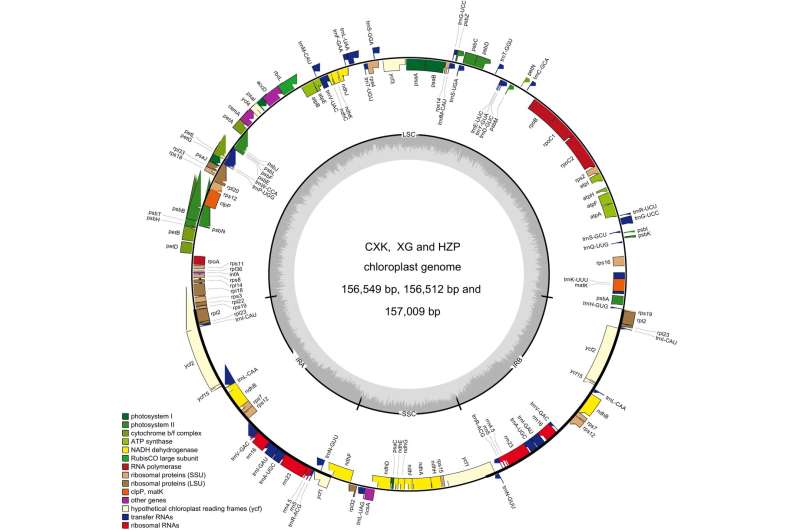This article has been reviewed according to Science X's editorial process and policies. Editors have highlighted the following attributes while ensuring the content's credibility:
fact-checked
trusted source
proofread
Chloroplast genome study separates C. meiocarpa and C. oleifera to enhance tea-oil camellia breeding

A research team sequenced and analyzed the complete chloroplast genomes of C. oleifera and C. meiocarpa, uncovering significant differences that clarified their phylogenetic relationship. This study developed 17 chloroplast DNA primers for distinguishing between them, contributing valuable tools for assessing genetic diversity in tea-oil Camellia.
These findings hold significant potential for future research and practical applications in germplasm resource assessment, molecular phylogenetic analysis, and the innovation and utilization of tea-oil Camellia in agricultural and industrial practices.
Tea-oil Camellia, known for its high oil content and health benefits, is a key woody oil crop with significant cultivation value, especially in China. Despite its importance, the phylogenetic relationships among tea-oil Camellia species, particularly between C. meiocarpa and C. oleifera, remain controversial due to complex nuclear genomes and interspecific hybridization.
Moreover, no reports exist on the chloroplast genome of C. meiocarpa, and no comparative analysis has been done between C. oleifera and C. meiocarpa. These unresolved issues hinder effective breeding and production.
A new study, published in Tropical Plants on 24 July 2024, aims to clarify these relationships by analyzing the chloroplast genomes of C. oleifera and C. meiocarpa and developing molecular markers for variety identification and resource utilization.
The research employed comparative genomics to analyze the chloroplast genomes of C. meiocarpa (CKX/XG) and C. oleifera (HZP), focusing on genome structures, repetitive sequences, IR region variations, nucleotide diversity, and phylogenetic relationships.
The chloroplast genomes exhibited a typical circular tetramerous structure with slight size differences among the species. Repetitive sequences and simple sequence repeats (SSRs) were distributed unevenly, with distinct patterns observed between the species. The expansion and contraction of the IR regions revealed genomic adaptations, particularly between HZP and CKX/XG.
Nucleotide diversity analysis highlighted the ycf1 gene as having the most mutations, and intergenic regions showed significant variation. Phylogenetic analysis confirmed that CKX and XG is not closely related to HZP.
Additionally, 56 pairs of primers were designed based on polymorphic sites, with 17 primers successfully validated for assessing polymorphic sites, providing essential tools for the identification and genetic study of tea-oil Camellia species.
According to the study's senior researcher, Daojun Zheng, "The present study provided high-quality chloroplast genomes and reliable molecular marker resources for future tea-oil Camellia research."
This study primarily investigated the chloroplast genomes of C. meiocarpa and C. oleifera, revealing significant genetic differences that support C. meiocarpa as an independent species. The development of 17 primers enhances species identification and resource assessment, benefiting breeding programs and production practices. These findings provide high-quality chloroplast genomes and reliable molecular marker resources for future tea-oil Camellia research.
More information: Heng Liang et al, Comparative chloroplast genome analysis of Camellia oleifera and C. meiocarpa: phylogenetic relationships, sequence variation and polymorphic markers, Tropical Plants (2024). DOI: 10.48130/tp-0024-0022
Provided by Chinese Academy of Sciences





















